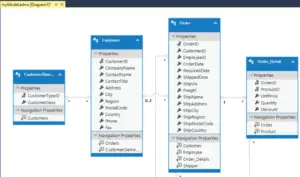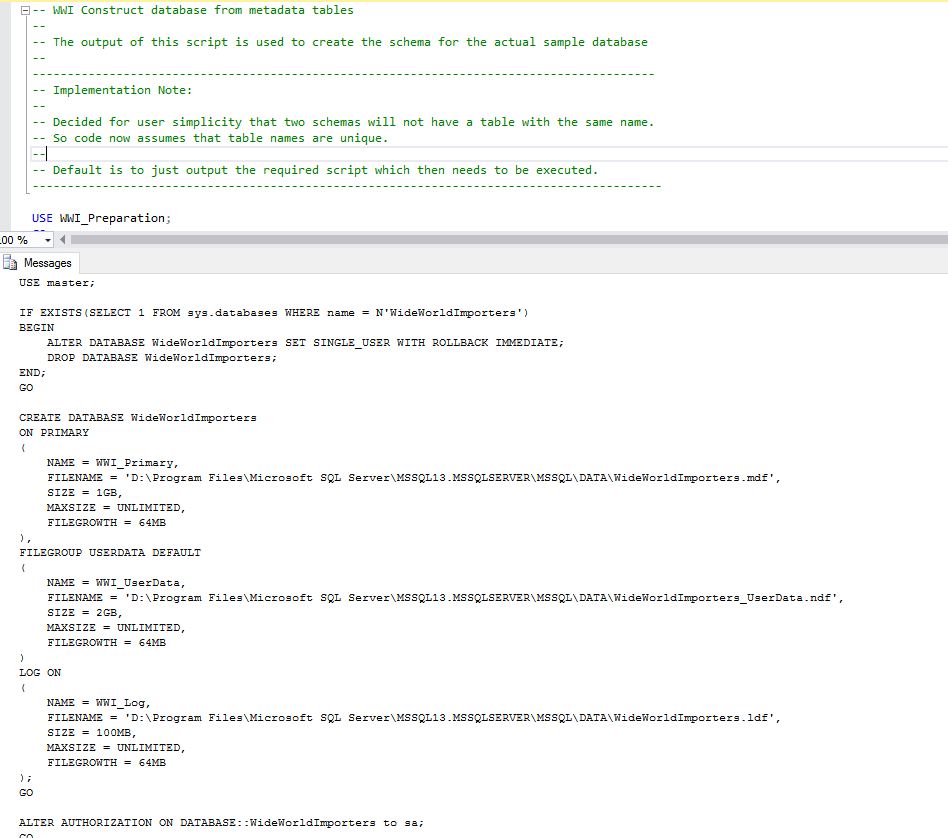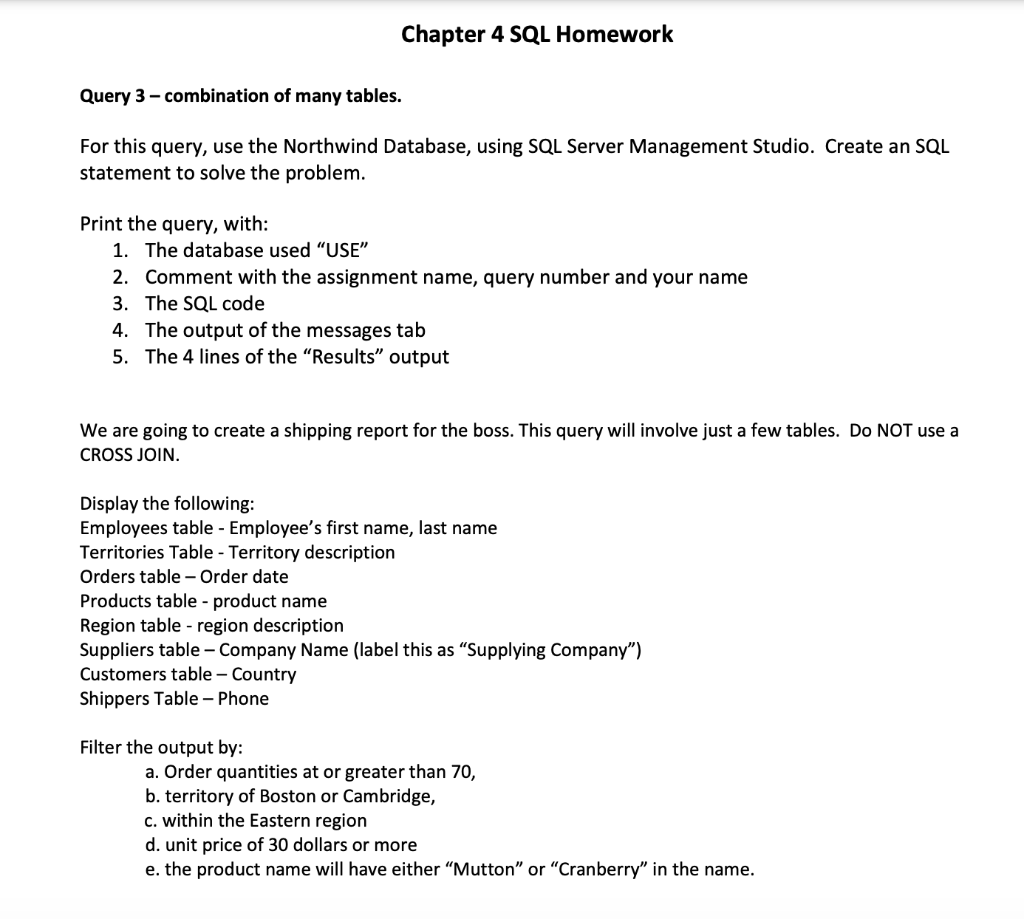-->
This walkthrough provides a fundamental end-to-end LINQ to SQL scenario with minimal complexities. You will create an entity class that models the Customers table in the sample Northwind database. You will then create a simple query to list customers who are located in London.
This walkthrough is code-oriented by design to help show LINQ to SQL concepts. Normally speaking, you would use the Object Relational Designer to create your object model.
- The following code example queries the Northwind database for the product with the ProductID value of 27. The value returned is an instance of the Product class, and the Console.WriteLine statement prints the name of the product.
- Northwind is the name of the sample database for SQL Server 2000, that later got replaced with the AdventureWorks sample database in SQL Server 2005. However, it is still used in e.g. Microsoft SQL Server 2008 Database Development Training Kit so may still be relevant for users trying to learn SQL essentials.
Subqueries Subqueries can be characterized in two main ways. One is by the expected number of values (either scalar or multivalued), and another is by the subquery's dependency on the outer query (either self-contained or correlated). Basic Queries of SQL Server Database Management Studio1. Get Order id, Product id, Unit price from Order Details.2. Find Title of employee Nancy.3. Download & View northwind database sql queries as PDF for free. Related Documents. Northwind Database Sql Queries June 2020 6.
Note
Your computer might show different names or locations for some of the Visual Studio user interface elements in the following instructions. The Visual Studio edition that you have and the settings that you use determine these elements. For more information, see Personalizing the IDE.
This walkthrough was written by using Visual C# Development Settings.
Prerequisites
This walkthrough uses a dedicated folder ('c:linqtest5') to hold files. Create this folder before you begin the walkthrough.
This walkthrough requires the Northwind sample database. If you do not have this database on your development computer, you can download it from the Microsoft download site. For instructions, see Downloading Sample Databases. After you have downloaded the database, copy the file to the c:linqtest5 folder.
Overview
This walkthrough consists of six main tasks:

Creating a LINQ to SQL solution in Visual Studio.
Mapping a class to a database table.
Designating properties on the class to represent database columns.
Specifying the connection to the Northwind database.
Creating a simple query to run against the database.
Executing the query and observing the results.
Creating a LINQ to SQL Solution
In this first task, you create a Visual Studio solution that contains the necessary references to build and run a LINQ to SQL project.
To create a LINQ to SQL solution
On the Visual Studio File menu, point to New, and then click Project.
In the Project types pane of the New Project dialog box, click Visual C#.
In the Templates pane, click Console Application.
In the Name box, type LinqConsoleApp.
In the Location box, verify where you want to store your project files.
Click OK.
Adding LINQ References and Directives
This walkthrough uses assemblies that might not be installed by default in your project. If System.Data.Linq is not listed as a reference in your project (expand the References node in Solution Explorer), add it, as explained in the following steps.
To add System.Data.Linq
In Solution Explorer, right-click References, and then click Add Reference.
In the Add Reference dialog box, click .NET, click the System.Data.Linq assembly, and then click OK.
The assembly is added to the project.
Add the following directives at the top of Program.cs:
Mapping a Class to a Database Table
Sql Database Queries Examples
In this step, you create a class and map it to a database table. Such a class is termed an entity class. Note that the mapping is accomplished by just adding the TableAttribute attribute. The Name property specifies the name of the table in the database.
To create an entity class and map it to a database table
Type or paste the following code into Program.cs immediately above the
Programclass declaration:
Designating Properties on the Class to Represent Database Columns
In this step, you accomplish several tasks.
You use the ColumnAttribute attribute to designate
CustomerIDandCityproperties on the entity class as representing columns in the database table.You designate the
CustomerIDproperty as representing a primary key column in the database.You designate
_CustomerIDand_Cityfields for private storage. LINQ to SQL can then store and retrieve values directly, instead of using public accessors that might include business logic.
To represent characteristics of two database columns
Type or paste the following code into Program.cs inside the curly braces for the
Customerclass.
Specifying the Connection to the Northwind Database
In this step you use a DataContext object to establish a connection between your code-based data structures and the database itself. The DataContext is the main channel through which you retrieve objects from the database and submit changes.
You also declare a Table<Customer> to act as the logical, typed table for your queries against the Customers table in the database. You will create and execute these queries in later steps.
To specify the database connection
Type or paste the following code into the
Mainmethod.Note that the
northwnd.mdffile is assumed to be in the linqtest5 folder. For more information, see the Prerequisites section earlier in this walkthrough.
Basic Sql Queries
Creating a Simple Query
In this step, you create a query to find which customers in the database Customers table are located in London. The query code in this step just describes the query. It does not execute it. This approach is known as deferred execution. For more information, see Introduction to LINQ Queries (C#).
You will also produce a log output to show the SQL commands that LINQ to SQL generates. This logging feature (which uses Log) is helpful in debugging, and in determining that the commands being sent to the database accurately represent your query.
To create a simple query
Type or paste the following code into the
Mainmethod after theTable<Customer>declaration.

Executing the Query
Sql Queries On Northwind Database
In this step, you actually execute the query. The query expressions you created in the previous steps are not evaluated until the results are needed. When you begin the foreach iteration, a SQL command is executed against the database and objects are materialized.
To execute the query
Type or paste the following code at the end of the
Mainmethod (after the query description).Press F5 to debug the application.
Note
If your application generates a run-time error, see the Troubleshooting section of Learning by Walkthroughs.
The query results in the console window should appear as follows:
ID=AROUT, City=LondonID=BSBEV, City=LondonID=CONSH, City=LondonID=EASTC, City=LondonID=NORTS, City=LondonID=SEVES, City=LondonPress Enter in the console window to close the application.
Northwind Database Script Sql
Next Steps
The Walkthrough: Querying Across Relationships (C#) topic continues where this walkthrough ends. The Query Across Relationships walkthrough demonstrates how LINQ to SQL can query across tables, similar to joins in a relational database.

Northwind Database Sql Queries Online
If you want to do the Query Across Relationships walkthrough, make sure to save the solution for the walkthrough you have just completed, which is a prerequisite.